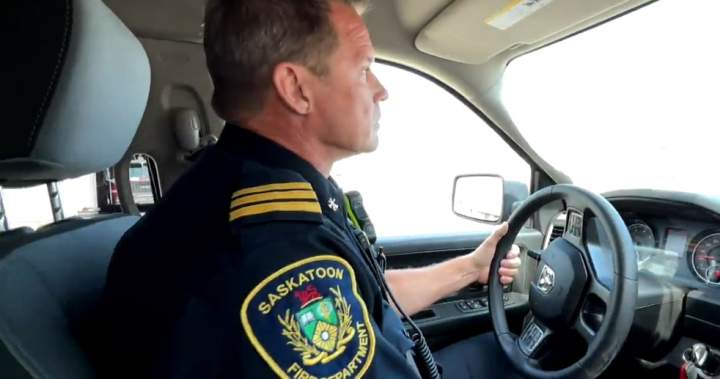I pulled on the heavy fire-resistant jacket, feeling the weight settle across my shoulders as Captain Mark Hadley nodded approvingly. “It’s just a ride-along, but we like our journalists properly equipped,” he said, checking my borrowed helmet one last time. After 16 years with Saskatoon Fire Department, Hadley’s movements were automatic, precise – the same careful attention he’d give to a rookie on their first shift.
This Wednesday morning at Fire Station No. 1 in downtown Saskatoon began quietly enough. The six-member crew had already completed equipment checks and morning training when I arrived. The station, one of nine serving Saskatoon’s growing population of 330,000, responds to approximately 16,000 calls annually – everything from medical emergencies to water rescues along the South Saskatchewan River.
“Most people think it’s all burning buildings and dramatic rescues,” Hadley explained as we toured the station. “Truth is, about 60 percent of our calls are medical responses. Heart attacks, overdoses, trauma – we’re often first on scene before ambulances arrive.”
The statistics back him up. According to Saskatoon Fire Department’s 2023 annual report, medical calls represented 9,600 of their total responses, while actual fires numbered just under 2,000. The remainder included hazardous materials incidents, water rescues, and alarm system activations.
The station itself feels like a curious mix of family home and high-tech emergency hub. In the kitchen, firefighter Sarah Chen was preparing a massive pot of chili for the crew’s lunch. “We cook together, eat together, and sometimes face the worst moments of people’s lives together,” she said, stirring the pot. “This place becomes your second family.”
That family atmosphere dissolved instantly when the alarm sounded at 10:17 a.m. The station erupted into controlled chaos – boots slid into place, equipment was grabbed, and within 45 seconds, we were in the engine, sirens wailing as we headed east toward the Sutherland neighborhood.
“Possible structure fire, residential,” the dispatcher’s voice crackled over the radio. “Reports of smoke visible from basement windows.”
Hadley gestured for me to secure my helmet as firefighter John Kapoor accelerated through an intersection, motorists pulling aside as our engine roared past. The adrenaline was immediate and overwhelming – and I was just an observer.
“Your heart rate up?” Kapoor called back with a quick grin. “Sixteen years in, and mine still jumps every time.”
We arrived at a small bungalow where smoke was indeed seeping from basement windows. Two other department vehicles – a ladder truck and rescue unit – arrived moments later. The precision of what followed was remarkable. Roles were clear, commands crisp, and movements deliberate as crews established a water supply, ventilation team, and search party.
“We train constantly for this choreography,” explained Assistant Chief Devon Mitchell, who arrived to oversee the scene. “When seconds matter, there’s no time for confusion about who does what.”
The homeowner, Margaret Fraser, 72, watched anxiously from her neighbor’s porch. “I was doing laundry when the lights flickered and I smelled something burning,” she told me, clutching her small terrier who’d been rescued first. “I called 911 right away.”
That quick thinking likely saved her home. The fire, caused by an electrical short in the basement laundry room, was contained within 20 minutes. While the basement suffered smoke and water damage, the main floor remained largely untouched.
“This is actually a success story,” Hadley told me as crews began cleanup operations. “Early detection, quick response, minimal spread. Not every call ends this well.”
As if to emphasize his point, our radios crackled again as we were preparing to leave. Medical emergency at a nearby retirement community – possible cardiac arrest. The rescue unit departed immediately, sirens fading into the distance.
Back at the station, the crew barely had time to refill water tanks before being dispatched to a three-vehicle collision on Circle Drive. I joined them, watching as they worked alongside paramedics to stabilize a young woman with neck injuries before extracting her from a crushed sedan.
“The hardest part of this job isn’t the danger,” firefighter Chen told me during a rare quiet moment between calls. “It’s the emotional weight. We see people on their absolute worst days, repeatedly. That takes a toll.”
Saskatoon Fire has recognized this reality. In 2022, they expanded their mental health program, providing confidential counseling services and implementing mandatory debriefings after traumatic calls. According to internal department statistics, participation in these programs has increased 35% over the past year.
“Twenty years ago, you just sucked it up,” reflected 29-year veteran Lieutenant Robert Standing. “Now we understand that approaching trauma that way leads to burnout, PTSD, and shortened careers. The culture has changed for the better.”
By late afternoon, the crew had responded to seven calls – the structure fire, three medical emergencies, the traffic accident, a false alarm at a downtown hotel, and a gas leak at a construction site. None made headlines, but each represented potential disaster averted.
“Most days are like this,” Hadley said as we watched the crew clean equipment after the final call. “Not glamorous, rarely dramatic enough for the news, but absolutely essential.”
The department faces growing challenges. Saskatoon’s population has increased by nearly 50,000 in the past decade, straining resources. New neighborhoods on the city’s edges have increased response times, and the opioid crisis has dramatically increased medical calls.
Fire Chief Richard Morgan addressed these concerns in a recent city council meeting, requesting funding for a new station in the Holmwood development area. “Our response times to the eastern sectors currently exceed our eight-minute target by almost three minutes,” Morgan noted in his presentation. “That gap represents lives and property at risk.”
As my ride-along ended, the evening crew arrived for shift change – a meticulous process of equipment checks, status updates, and handover briefings. The departing firefighters headed home to families, hobbies, and second jobs – lives deliberately separated from the emergencies they navigate daily.
“People often ask if this job changes you,” Hadley said as he walked me out. “Of course it does. You see humanity at its most vulnerable, most desperate moments. But you also see incredible resilience, strangers helping strangers, and the difference quick action can make.”
He paused, looking back at the station where another crew now waited for the alarm to sound.
“That’s what keeps us coming back,” he said simply. “Knowing that on someone’s worst day, we might be the difference that matters.”






